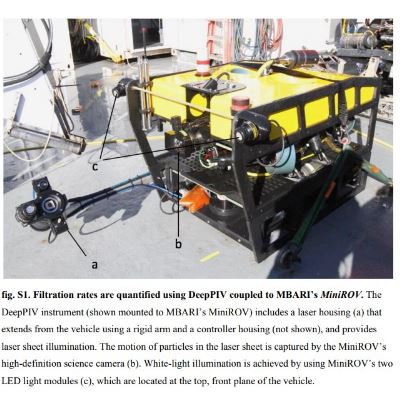In this issue:

To accurately assess the impacts of climate change on our planet, modeling of oceanic systems and understanding how atmospheric carbon is transported from surface waters to the deep benthos are required. The biological pump drives the transport of carbon through the ocean’s depths, and the rates at which carbon is removed and sequestered are often dependent on the grazing abilities of surface and midwater organisms. Some of the most effective and abundant midwater grazers are filter-feeding invertebrates. Although the impact of smaller, near-surface filter feeders is generally known, efforts to quantify the impact of deeper filter feeders, such as giant larvaceans, have been unsuccessful. Giant larvaceans occupy the upper 400 m of the water column, where they build complex mucus filtering structures that reach diameters greater than 1 m. Because of the fragility of these structures, direct measurements of filtration rates require in situ methods.
To quantify the filtration impact of giant larvaceans in situ, researchers at the Monterey Bay Aquarium Research Institute (MBARI) developed DeepPIV, an instrument that allows for the quantitative visualization of fluid motion through particle tracking and particle image velocimetry (PIV). Unlike earlier versions of this technology, DeepPIV can be deployed from remotely operated vehicle (ROV’s) that are capable of diving to depths where giant larvaceans and other midwater organisms are found.
The DeepPIV consists of a laser housing deployed via a rigid arm that attaches to an ROV. Within the laser housing is a Laserglow 1W 671-nm continuous wave laser with line-generating optics that illuminates a sheet of light in front a ROV camera. DeepPIV uses a laser sheet coupled to a high-resolution video camera to illuminate and record suspended particles moving in seawater. By mounting the instrument on an ROV trimmed to near-neutral buoyancy, fine control of the vehicle and subsequent positioning of the instrument can be achieved by a pilot aboard a surface vessel. With this system, quantitative visualizations of fine-scale fluid motion can be achieved from the sea surface to the maximum depth rating of the ROV.
Unlike conventional light sources like light-emitting diodes (LEDs) or gas-discharge lamps that provide detail on the external surfaces of Giant larvaceans, but yield minimal information about the internal structures and processes, DeepPIV’s laser sheet can penetrate to illuminate particle motion within the tail chamber and inside the inner feeding filter. In addition, laser sheet illumination provides the necessary contrasting agent to distinguish between the particle-laden, water-filled cavities and the mucoid structures within the larvacean house. Thus, ROV deployments with DeepPIV provide a new means to measure filtration rates and small-scale biological fluid interactions while also enabling the description and measurement of complex morphology within gelatinous or mucus structures. Technologies such as DeepPIV will enable more accurate assessments of the long-term removal of atmospheric carbon by deep-water biota.
To read more about this exciting research, please -
Click Here
To learn more about the laser used in the research, please visit -
Click Here
